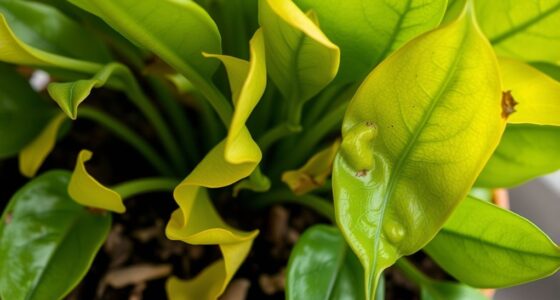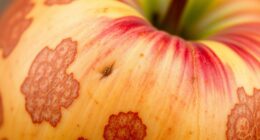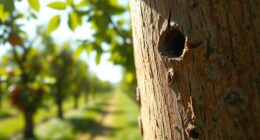If your plant shows yellowing leaves, it might be overwatering or underwatering. Dry, brittle leaves suggest underwatering, while soggy soil with wilting indicates overwatering. Look out for pests like tiny insects, sticky residue, or webbing—these signs point to infestations needing targeted treatment. Discolored or deformed leaves could signal nutrient deficiencies or other issues. By checking soil moisture and inspecting for pests, you can spot problems early—your plant needs your careful attention. Keep exploring to learn more tips!
Key Takeaways
- Observe leaf color and texture for signs of overwatering (yellowing, soggy soil) or underwatering (dry, brittle leaves).
- Check soil moisture with a finger or moisture meter to identify hydration issues.
- Look for pests like aphids or spider mites, indicated by webbing, sticky residue, or plant deformities.
- Ensure proper drainage to prevent water stagnation and root rot.
- Inspect undersides of leaves and hidden areas regularly for early pest detection and prevention.

Plants can develop a variety of issues that hinder their growth and health, but many problems are easy to identify once you know what to look for. One of the most common causes of trouble is watering issues. Overwatering can cause roots to rot, leading to yellowing leaves, wilting, and a soggy soil smell. Underwatering, on the other hand, often results in dry, brittle leaves and a general droopiness, as the plant struggles to access the moisture it needs. To diagnose watering problems, check the soil moisture with your finger or a moisture meter. If the soil feels wet and your plant still appears wilted, it’s likely overwatered. If it’s dry several inches down and the plant droops, underwatering might be the culprit. Adjust your watering schedule accordingly—allow the top inch of soil to dry out before watering again, and guarantee your pot has proper drainage to prevent water from stagnating. Additionally, understanding the importance of soil drainage can help prevent water from accumulating and causing root problems. Pest identification is another vital step in diagnosing plant issues. Pests like aphids, spider mites, mealybugs, or scale insects can cause significant damage, often showing up as tiny specks, sticky residue, or webbing on leaves and stems. You might notice a decline in plant vigor, deformities, or discoloration that doesn’t match typical watering problems. Carefully inspect your plant, especially the undersides of leaves and hidden crevices, for signs of pests. Recognizing these pests early is key to controlling their spread and minimizing damage. Use a magnifying glass if needed to spot small insects or eggs. Once identified, you can treat infestations with insecticidal soap, neem oil, or manual removal, depending on the pest type. Combining your observations of watering issues and pest identification can help you quickly narrow down the problem. For instance, if your plant’s leaves are yellowing and the soil is consistently wet, overwatering and possible root rot are likely issues. If you see tiny insects clustered on the stems with sticky residue, pests are probably the cause. Being vigilant and routinely inspecting your plants allows you to catch problems early before they escalate. Remember, healthy plants are often a matter of catching issues early and adjusting your care routine. Regularly checking soil moisture and inspecting for pests can prevent many common plant problems, keeping your green friends thriving and beautiful.
Frequently Asked Questions
How Often Should I Water My Plant?
You should establish a consistent watering schedule suited to your plant’s needs. Generally, water when the top inch of soil feels dry to prevent drought stress. Overwatering can cause root rot, so guarantee proper drainage. Check your plant regularly, adjusting your watering frequency based on its environment and season. Remember, each plant type has unique requirements, so observe your plant closely to maintain ideal health.
Can I Save a Severely Damaged Plant?
You can often save a severely damaged plant with a proper plant rescue and damage assessment. Start by carefully inspecting the plant to identify dead or rotting parts. Remove any damaged foliage or stems, and adjust watering and light conditions to encourage recovery. With patience and proper care, you might revive your plant, but the key is acting quickly and monitoring its progress closely to give it the best chance to bounce back.
What Soil Is Best for My Specific Plant?
Think of your plant’s soil as its foundation, shaping its growth like the roots of a story. You should select soil with the right composition—well-draining, aerated, and rich in organic matter—to meet its nutrient requirements. Pay attention to specific needs, whether it’s acidic, neutral, or alkaline. By choosing the appropriate soil, you set the stage for vibrant health and thriving growth, giving your plant the support it needs to flourish.
How Do I Prevent Pests Naturally?
To prevent pests naturally, you should practice companion planting, which involves growing certain plants together to repel harmful insects. Attract beneficial insects like ladybugs and lacewings by planting nectar-rich flowers nearby, as they prey on pests. Avoid chemical pesticides, and instead, encourage a balanced ecosystem that keeps pests in check. Regularly inspect your plants for early signs of trouble, and foster a healthy environment for beneficial insects to thrive.
When Is the Right Time to Repot?
Imagine your plant gently outgrowing its pot, like a child outgrowing shoes. The right time to repot is when you notice roots through the drainage holes or the plant’s growth slows despite good care. Follow a regular repotting schedule, typically every 1-2 years, depending on plant size. This helps guarantee healthy growth, prevents root bound problems, and keeps your plant thriving.
Conclusion
Don’t worry if your plant shows signs of trouble; most issues are easy to fix once you identify the problem. Even if you’re new to gardening, paying close attention to your plant’s needs can make all the difference. Remember, every plant is unique, so it might take a little patience and observation. With a little care, you’ll help your plant thrive again—showing that even beginners can succeed with a bit of guidance.









